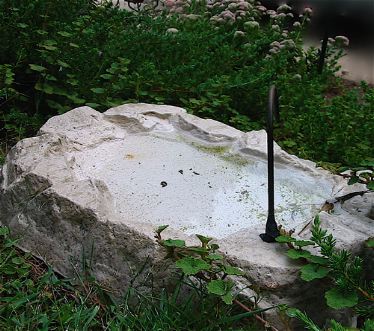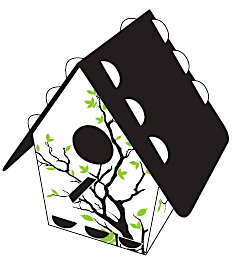-
Add a Birdbath for Wildlife Friendly Habitat
Our North Georgia yard is always fluttering with avian activity. Probably due to the many bird feeders and birdhouses, but positively because of the birdbaths and water features. For the last 30 days or so I think it has rained only once. Pastures and lawns are parched, and flowers that usually thrive well into fall have seen better days.
Two pedestal baths each have their own gizmo so there’s always moving water. One has a dripper, the other a water wiggler. Since this water always moves, it is a major attractor for birds, it works like a visual magnet! It’s also good to know that mosquitoes can not lay their eggs in these birdbaths.
This ground birdbath with an attached dripper has got to be by far the most popular spot. Of course everyone took off when I went to take the picture. There’s also a leaf mister staked in the ground nearby, which shares the same water connection via a T-connector in the rubber tubing. Butterflies, hummingbirds and most of the regulars frequent this spot daily. Some birds even crowd around to wait their turn for a dip in this great birdbath!
The landscaping helps too, lush and mature trees, shrubs and flowers, with perennials for butterflies like lantana, milkweed, and butterfly bush. A shepherd’s hook with three bird feeders is also close to this water feature. I guess if I were a bird, it would be a pretty decent spot to hang around!
-
Crowded Thistle Feeders?
With tons of Goldfinches out and about now, thistle feeders are likely to be a very busy spot in your yard. Because Goldfinches are one of the latest breeding/nesting birds, many juveniles are now crowding thistle feeders and learning to eat on their own. One of the favorite songbirds who will winter-over if thistle (or nyjer) is offered on a consistent basis, Goldfinches will grace your garden all year. A heated birdbath is also another major attraction for these sweet birds to stick around.
With one of their two upcoming seasonal molts, vibrant yellow plumage will soon give way to a more olive-drab one. But as spring once again approaches, the electric yellow feathers will be seen through late summer and early fall.
The use of Thistle Socks or Thistle bags will help to alleviate crowds at your regular thistle feeders, and ensure that all babies get to eat. Fairly inexpensive and available from small to large, these mesh stockings provide an “all-over” eating area for finches and other birds who prefer thistle seed.
Cardinals are also molting right now, and although they might look a bit sickly…rest assured it’s just the process of shedding old worn feathers for vibrant new ones.
-
A New Generation of Birdhouse Kits
Innovative designs seem to bring about a new twist on old things. Totally fun and functional, these birdhouse kits are fun for children and adults to assemble. No tools required either! They’re made from recycled plastics, and come in some vibrant colors and designs.
They’re meant for feathered friends, to provide real nesting sites in spring. Bird will also use these fun birdhouses to roost on cold winter nights, for protection from predators, and the elements as well. By adding some dried grasses or clean straw, you’ll provide some extra insulation from the cold.
Birdhouse kits make wonderful projects for school or church groups, Brownies, Boy Scouts or any activities group. They’ll help teach a valuable lesson on stewardship for the environment and creating a wildlife friendly habitat with three main elements. Food, Water and Shelter. Help kids learn about native plantings that will provide food and shelter for birds. Water can be as simple as a plant saucer on the ground filled with fresh water.
You can help local bird populations thrive and flourish by teaching the next generation about wildlife friendly habitat.
These birdhouse kits just may grab their attention and make the project fun!






